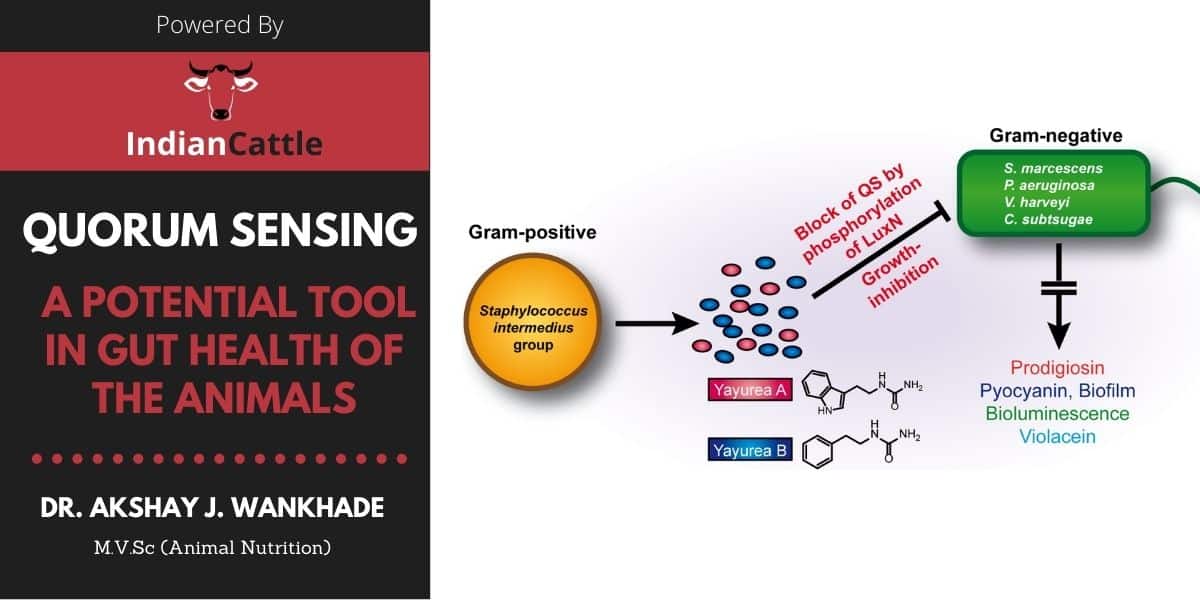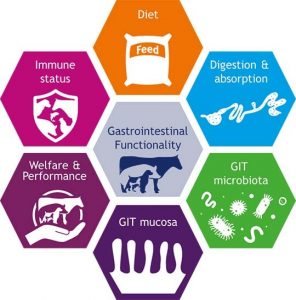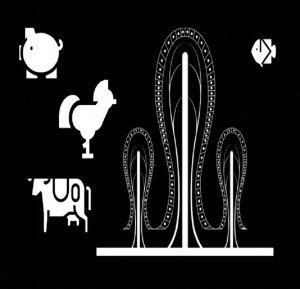
Quorum Sensing: A Potential Tool in Gut Health of the Animals
Quorum Sensing
- The Gut microbiota plays a principal part in protecting an animal from enteric bacterial infection. But many intestinal pathogens have developed strategies to outcompete the intestinal community, leading to infection and disease.
- One way pathogenic bacteria impede the gut microbiota is by using alternative nutrients, such as microbiota-derived sources of carbon and nitrogen. They also exploit regulatory signals from the microbiota and the host to promote their own growth and virulence. This signaling among bacteria is referred to as quorum sensing (QS).
Autoinducers
- Numerous bacterial species make small-molecule signals, called autoinducers (AI), that they release into their immediate environment to track changes in cell numbers. As the bacterial population grows, increasing in density, AI concentrations also accumulate
- When AI levels reach threshold, a series of events are triggered inside bacteria that ultimately result in changing the bacterial population’s behaviour and enable it to act as a large multicellular organism.

Mechanism:
For the bacteria to use quorum sensing constitutively, they must possess three characteristics:
- to secrete a signaling molecule, an autoinducer,
- to detect the change in concentration of signaling molecules and
- to regulate gene transcription as a response
- This process is highly dependent on the diffusion mechanism of the signaling molecules. QS signaling molecules are usually secreted at a low level by individual bacteria.
- At low cell density, the molecules may just diffuse away. At high cell density, the local concentration of signaling molecules may exceed its threshold level, and trigger changes in gene expressions.
Gram-positive Bacteria:
- They use Autoinducing peptide (AIP) as their autoinducers
- When high concentration of AIP is detected by them , AIP binds to a receptor to activate a kinase. The kinase phosphorylates a transcription factor, which regulates gene transcription. This is called a two-component system.
- Another possible mechanism is that AIP is transported into the cytosol, and binds directly to a transcription factor to initiate or inhibit transcription.
Gram-negative Bacteria:
They produce N-acyl homoserine lactones (AHL) as their signaling molecule. Usually these do not need additional processing, and bind directly to transcription factors to regulate gene expression.

Important Behaviours Governed by QS are:
- Antibiotic resistance
- Virulence expression
- QS enables bacterial populations to achieve a population large enough for virulence factor expression, such as the production of extracellular toxins that damage the intestinal wall, reduce productivity and cause clinical disease.
- Most QS systems promote communication between bacteria of the same species (intraspecies communication), with gram-positive and gram-negative bacteria using different systems to talk among themselves. However, many bacteria have a second QS system that is thought to enable communication between different bacterial genera (interspecies communication).
- More recently, bacterial communication has been shown to cross kingdom boundaries with the recognition that some bacteria sense host signalling chemicals such as the hormones adrenaline and noradrenaline.
Potential Promise of QS:
- Many bacterial species relevant to livestock production and veterinary medicine, including those mentioned previously, use QS to regulate production of virulence factors that are essential for bacterial infection.
- Preventing bacteria from producing virulence factors could be an important alternative strategy, known as antivirulence therapy, for combating bacterial diseases.
- Scientists have identified three routes to interfere with QS systems as part of an antivirulence strategy:
- inhibiting the making of QS signal molecules,
- inhibiting the interaction between a QS signal molecule and its related receptor and
- quenching of extracellular QS signal molecules through neutralisation or degradation.
Quorum Sensing in Gut Health:
Polyphenols for example show the ability to inhibit quorum sensing and thus affecting biofilm formation in some bacteria. As they do not affect the intestinal microbiota, they prevent simultaneously the concurrent invasion of pathogens by supporting a balanced microbiota.
- Curcumin: the active substance of Curcuma longa root, inhibits the expression of virulence genes in Pseudomonas aeruginosa.
- Furanones: in strawberries for instance, interfere with AI-regulated processes in Pseudomonas aeruginosa by accelerating the degradation of the AI-receptor protein.
- Isolimonic acid: an active compound of citrus fruits-seeds interferes biofilm formation in E. coli due to inhibition of AI-activity.
- Carvacrol: antimicrobial component present in the oregano oil as well as of peppermint interferes with AHL regulated virulence factors and thus inhibits biofilm formation of several gram-negatives.
- Piperine: in black pepper, exhibits QS inhibitory effect by impeding the activity of receptors and molecules involved in QS pathway required for biofilm formation of Str. Mutans.
- Furocoumarins: in grapefruit, inhibitory effects on autoinducer activities, subsequent biofilm formation of several gram-negative bacteria like E.coli and S. typhimurium.
- Hydrolysed tannins: an extract of Mangifera indica, exhibits a broad spectrum of anti-QS activities including prevention of AHLs activity. The extract had a protein binding activity and thus may disrupt QS either by inactivating enzymes responsible for AIs-synthesis or binding to protein receptors of QS signals.
QS inhibition by plant-based extracts result into loss of communication between the pathogenic bacteria. Due to proper functioning of the healthy gut and microbiota, digestion and metabolism of the nutrients take place properly. It ultimately boosts up the immune system of the animals. This shows that quorum sensing inhibition in animal nutrition can be a potential tool to support the animals’ resilience and wellbeing through improvement in gut health.
Read: Role of Animal Husbandry Sector in Development of Atmanirbhar Bharat
M.V.Sc (Animal Nutrition)
Fine Organics Industries Limited
Mobile No. 8657580179
